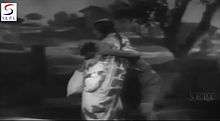Brahmachari (1938 film)
| Brahmachari | |
|---|---|
| Directed by | Master Vinayak |
| Written by |
P. K. Atre (story and dialogues for Marathi version) Pandit Indra (dialogues for Hindi version) |
| Starring |
Master Vinayak Meenakshi Shirodkar Damuanna Malvankar |
| Music by | Dada Chandekar |
| Cinematography | Pandurang Naik |
Release dates |
|
| Country | India |
| Language |
Marathi Hindi |

Brahmachari (English: Celibate) is a 1938 black and white Marathi film. The film was directed by Master Vinayak and written by Pralhad Keshav Atre and starred Master Vinayak himself along with Meenakshi Shirodkar in lead roles. The film was a political satire targeted on the Hindu nationalist organization Rashtriya Swayamsevak Sangh. The film was also made in Hindi language.
Atre paired with Master Vinayak for the second time for this film after the 1937 film Dharmaveer. Apart from the witty dialogues and satirical theme, the film became popular for Shirodkar's seductive song sequence wearing a swimsuit.
Plot
Audumbar is a young and ordinary man. On one occasion he happens to listen to the lecture given by Deshbhakta Jatashankar. Jatashankar in his speech emphasizes on discipline and celibacy, the principals of the Rashtriya Swayamsevak Sangh. This speech inspires Audumbar and he decides to join the institute of Acharya Chandiram. He renounces his sexual desires and also throws away his collection of posters of film actors.
But at the institute, he comes across Kishori, a young woman and all his vows to Brahmacharya are tested.
Cast

- Master Vinayak as Audumbar / Kanhaiya (in Hindi version)
- Meenakshi Shirodkar as Kishori
- V.G. Jog
- Salvi
- Damuanna Malvankar as Acharya Chandiram
- Javdekar as Deshbhakta Jatashankar
- Vasant Eric
Production
Pralhad Keshav Atre, who had previously published many novels, poems and also written stories and dialogues for films, paired with Master Vinayak for the second time for this film. Previously they had worked together on the 1937 Marathi film Dharmaveer, which was a religious satire.[1]
The film was actress Meenakshi Shirodkar's debut film.[2] She had previously worked in theatre. The film became notable for the song sequence "Yamuna Jali Khelu Khel" where Shirodkar wore a swimsuit. The scene involved the character Kishori trying to seduce Audumbar while bathing on a ghat.
Reception and legacy
The film had dialogues written by Atre, who is known for his sense of humour.[3] His satirical handling of political nationalist party Rashtriya Swayamsevak Sangh's ideologies in the Marathi medium and Pandit Indra's writing for the Hindi medium brought in audiences. Critics have also credited the success of the film to these strong dialogue writers.[4][5] Apart from the dialogues, the film's main attraction was Shirodkar's song sequence with the swimsuit that brought repeat audience and also brought fame to Shirodkar.[4][6] The film was a hit at box-office and ran for twenty five weeks in Mumbai and for fifty in Pune.[7] The then critics had also criticized the bold song sequence.[8]
After stunning the traditional Marathi audience and despite the criticism for the bold scene, the film brought popularity for Shirodkar.[9][10] Her twin-plait hairstyle also became popular and trendy in teenage girls. The pair of Master Vinayak and Shirodkar was well received by audiences. The two went on to play successful lead roles in various film like Brandichi Batli (1939), Ardhangi / Ghar Ki Rani (1940), Amrut (1941), Mazhe Bal (1943) and more.[6]
The film was also adapted as a play of same name in 1984. It starred Prashant Damle and Varsha Usgaonkar in lead roles and was directed by Damu Kenkre. The music was revived by Ashok Patki and the popular song "Yamuna Jali Khelu Khel" was still maintained with Usgaonkar now in swimsuit trying to seduce Damle.[11] The play proved to be a turning point for the current female lead also. Usgaonkar was noticed by director-actor Sachin Pilgaonkar, who then launched her in films through Gammat Jammat.[12][13]
The song "Yamuna Jali Khelu Khel" still remains popular. After its use in Kenkre's play, the song was recently also used in the film Pratibimb (2011). Sung by new comer Sampada Hire, the music is composed by Avadhoot Gupte and is picturised on Ankush Choudhary and Sonali Kulkarni.[14]
References
- ↑ Purohit, Vinayak (1988). Arts of Transitional India Twentieth Century. Popular Prakashan. p. 1041. ISBN 0861321383. Retrieved 1 November 2012.
- ↑ Chatterjee, Saibal; Menezes, Saira (28 February 1996). "Gorgeous Ghatans". Outlook India. Retrieved 20 November 2012.
- ↑ George, K. M. (1992). Modern Indian Literature: An Anthology, Volume 3. Sahitya Akademi. p. 274. ISBN 8172013248. Retrieved 15 January 2013.
- 1 2 "Brahmachari". Upperstall. Retrieved 1 November 2012.
- ↑ Dwaire, Rachael (22 September 2012). "फिल्मी जादू: हिंदी हास्य के सुल्तान". New Delhi: Aaj Tak. Retrieved 15 January 2013.
- 1 2 "हिंदी सिनेमा का सफ़र -3 (पुराने जमाने में भी हिट थीं जोड़ियां)" (in Hindi). Janokti. 13 October 2010. Retrieved 15 January 2013.
- ↑ Mujawar, Isak (1969). Maharashtra: Birthplace of Indian film Industry. University of Michigan and Chief Information Officer, Maharashtra Information Centre. p. 43. Retrieved 15 January 2013.
- ↑ "स्मिता गोंदकरला झालयं तरी काय?" (in Marathi). Loksatta. 16 March 2012. Retrieved 15 January 2013.
- ↑ "Veteran Marathi actress dead". Mumbai: Indian Express. 4 June 1997. Archived from the original on 30 December 2012. Retrieved 17 January 2013.
- ↑ Kaur, Pawanpreet (16 September 2012). "A potpourri of trivia for cinephiles & nerds". The Guardian. Retrieved 15 January 2013.
- ↑ "अशोक पत्की" (in Marathi). Maharashtra Times. Retrieved 15 January 2013.
- ↑ Sakhardande, Prajal (18 December 2012). "Goa's emerald eyed 'Sridevi'". Goa: Navhind Times. Retrieved 15 January 2013.
- ↑ Shahane, Devayani (27 January 2002). "Back to the basics". Pune: Times of India. Retrieved 15 January 2013.
- ↑ "यमुनाजळी खेळू खेळ..." (in Marathi). Lokprabha. 9 December 2011. Retrieved 16 January 2013.
External links
| Wikimedia Commons has media related to Brahmachari. |